- Know about the deep connect between Kashi and Tamilagam. Cultural influences and two way movement of the learned between Kashi and modern day Tamil Nadu for e.g. Rajaraja Chola-I and Rajendra Chola, had their Shiva
Diksha from their Rajagurus Ishana Shiva Pandita and Sarva Shiva Pandita, who hailed from Malawa (MP) and Vanga (Bengal).
Kashi,
the city of light, as it is most commonly known in Tamilagam has been the
epicenter of spiritual wisdom, sadhana and various expressions of bhakti.
Every practicing Sanatani, especially the follower of the Shaiva Marga, has a unique encounter and take away from the experience of Kashi. Kashi-yatra is not a mere journey to a holy city, it is the consummation of one’s lifelong Tapasya, the very goal of his human
existence.
In
Kashi one finds a sacred geography, built environment; sacred routes; and a
pointer to the journey to another life. Like any other Kshetra, Kashi too
comprises of divine, natural and human-made assemblages of sacred symbols.
Kashi was also recognised as one of the foremost centres of learning, thereby
facilitating the exchange of students from various parts of the Bharat who
would converge to Kashi.
Puranic
lore establishes the connection between the two centres of knowledge, Kashi and
Tamilagam in more than one way. While Kashi Vishvanatha and Rameshvara are a
part of the Dvadasha Jyotirlinga circuit, Kashi and Kanchipuram are also
considered part of seven cities that bestow liberation (Mokshapuri). Another set of temples which confer liberation owing
to different causative factors also include Kashi. The rest being Chidambaram,
Thiruvannamalai
and Tiruvarur,
all located in Tamilagam.
Darshanaat Abhrasadasi Jananaat Kamalaalaye |
Kaashyaam tu maranaat muktiH smaranaat arunaachale ||
In Kanchi, one can find ample evidences for the close ties
between the two cities.
According to the Kamakshivilasa
section of Markandeya Purana, which glorifies the sacred temple of Kamakshi in
Kanchi, Kashi is said to one of the eyes of Mahadeva, the other being Kanchi:
netradvayam maheshasya kashikanchipuradvayam |
It
is described in the Sthalapurana of
Ekamreshvara that, Goddess Uma on her travel from Badarikashrama, first reached
Kashi and assumed the form of Annapurna to relieve the people of their hunger
due to a famine, and later continued her journey south and finally reached Kanchi. Hence Kashi has always been on the
travel path to South of India, a tradition which continues till today.
Many
temples in Kanchi such as Saptarishi Lingas, Piravadishvara, Iravadishvara,
Makaleshvara have legends connected with Kashi.
Rameshvaram and Kashi also form part of the Char Dham Yatra, popular amongst the devotees, especially from the north of Vindhyas. Whereas for those from the Dakshina Bharat (South India), the Kashi yatra commences with the darshan of Rameshvaram. The Yatrika would gather the holy sand from Setu and divide it into three portions. One portion would be worshipped as Setu Madhava in Rameshwaram itself and ceremonially disposed. He would then proceed first to Prayagaraj and worship Veni Madhava and ceremoniously immerse the second portion in the holy confluence of the three rivers- Ganga, Yamuna and Guptasarasvati. Proceeding further to Kashi, the third would be immersed near Dashashvamedhaghat in honour of Bindu Madhava. Holy waters from mother Ganga would be collected and brought back again to Rameshvara and offered for abhisheka of Ramanatha Swami. This marked the completion of Kashi Yatra.
Those who are eligible would also offer Shraddha in Prayagraj and Kashi in addition to Gaya.
To
commemorate the connection between the two Dhams, Kashi
Vishvanath and Rameshvara Suprabhatam
sung by MS Subbulakshmi was released in 1977 in a grand manner. The
Suprabhata used to be broadcasted from Baba Vishvanath Dham in the initial
years, but stopped somewhere in 1983. But, with the recent inauguration of
Vishvanath Corridor, the broadcast of the Suprabhatam has commenced again.
The
revival of Shaiva Bhakti in the seventh through ninth centuries in Tamilagam,
by the various Nayanmars (saints) incited a revival, a reassertion of
distinctively Sanatana elements that were dormant during a period of Jain and
Buddhist cultural hegemony in Tamilagm.
The
Pashupata schools were active and found many royal supporters. In places like
Chidambaram and Thiruvarur, branches of Shaiva Mathas such as Golaki were
opened. Rajaraja Chola-I and Rajendra Chola, had their Shiva Diksha from their Rajagurus Ishana Shiva Pandita and Sarva Shiva Pandita, who belonged to the Siddhanta Shaiva and hailed from Malawa (MP) and Vanga (Bengal). There were many
Mathas of the same Siddhanta-marga in Kashi, as evident from many inscriptional
evidences.
There
was a reverse migration of Siddhanta Shaiva scholars too. Kumaraguruparar
(founded Kumaraswamy Mutt), born in Thirunelveli region, was blessed with
exceptional wisdom by the grace of Lord Jayantinatha of Thiruchendur. He was
initiated into Shaiva path by Gurumahsannidhanam Sri Masilamani Desigar of
Dharmapura Adheenam, a Shaiva Mutt.
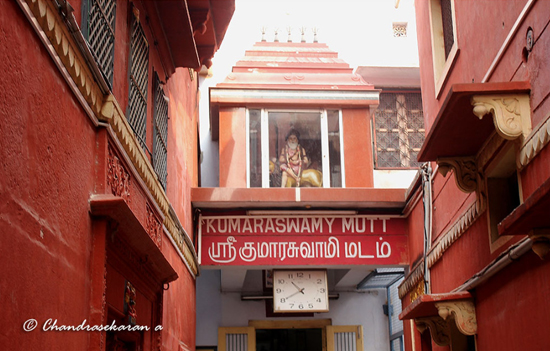 Kumaraswamy Mutt, Kashi.
Kumaraswamy Mutt, Kashi.
Knowing
the greatness of his disciple and also realising the need for learned scholars
in Shaiva Siddhanta in Kashi, Mahasannidhanam directed Kumaraguruparar to go to
Kashi. He displayed exceptional polemical skills in the learned assembly of
Kashi and soon was accepted as one of the foremost scholars of Shaiva
Siddhanta. The Kashi was under the control of Dara Shikoh, the tolerant and
learned son of Shah Jahan.
Still,
to gain an easy access, using his yogic siddhis, Kumaraguruparar reached the
assembly called upon by Dara, riding on a tiger. He also made a deep impact by
his powerful arguments and knowledge of multiple systems of philosophies. Dara
venerated the saint after the speech and granted him permission and land to
build a Shaiva Mutt and funds required for the renovation of Kedareshvara
Temple.
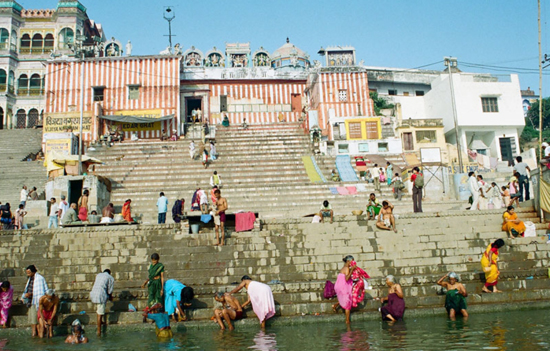 Vijayanagar Ghat /Kedar Ghat. 2013.
Vijayanagar Ghat /Kedar Ghat. 2013.
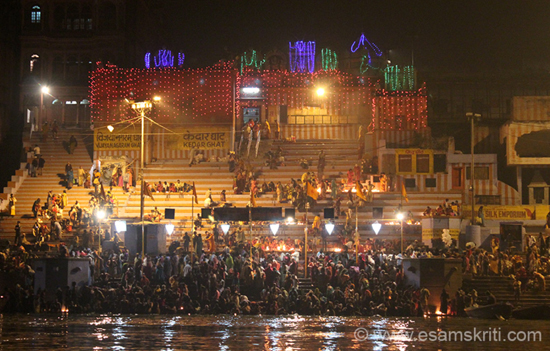 Same ghats early morning on Kartik Purnima. 2013.
Same ghats early morning on Kartik Purnima. 2013.
Sri
Kumaraguruparar renovated the Kedar Ghat, rebuilt the Kedareshvara temple on
the ghat, which is incidentally the southernmost fork of the trishula, the form
in which Kashi was in Krta Yuga. The three forks of trident were represented by
the three Shiva lingas, i.e. Omkareshvara in the north, Vishveshvara in the
centre, and Kedareshvara in the south. (Kashi is said to be in the form of
trishula in krta Yuga, Disk in Teta Yuga, chariot in Dvapara Yuga and a conch
in Kali Yuga, where in each of the points are the forms marked by a sacred
shrine located in Kashi.
Temples in Kashi were destroyed by the Islamic rulers many times-in 1194, by Muhammad Ghori's general Qutb-ud-din Aibak, in 1300s by Firoz Shah Tughlaq in1400s by the Sharqi kings of Jaunpur and finally in 1669 by Aurangzeb. Kashi has managed to resurrect itself every time it has come under attack, but it did not resurface in Kashi alone, but it did so in countless places all over India. There are more than hundred temples in Tamilagam alone which are designated as Kashi Vishvanatha temple.
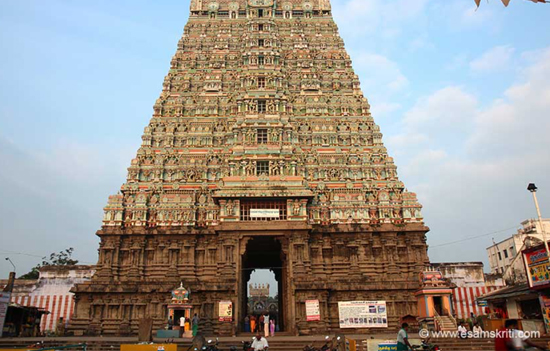 Kashi Vishwanathat Mandir, Tenkasi, Tamil Nadu. 2016.
Kashi Vishwanathat Mandir, Tenkasi, Tamil Nadu. 2016.
The
inscription of Jatilavarama parakrama Pandya in Tenkasi narrates the legend behind
the construction the Kashi Vishvanathar temple in Tenkasi, a town deep south of
Tamil Nadu.
Pandyas were sufficiently weakened due to the Muslim invasion and the subsequent shift of power in the hands of Nayakas. They had to leave their traditional capital, Madurai, and were forced to rule over a small principality in Thirunelveli region. There was a King named Jatilavarma Parakrama Pandya, who ruled the Shenbagapozhil area. Once, he had a strange dream in which Lord Shiva reminded him of a Shivalinga which was worshiped by the Pandya's ancestors which now laid in the Shenbaga (Magnolia) forest.
As
a marker he indicated that if the king would follow the ants crawling out of
the fort they would converge in the place wherein the Shivalinga was buried.
The Lord also directed the king to build a temple, since due to the distance
and many other social factors, His devotees were unable to visit Kashi to have
His darshan. To give them the merits equal to that of visiting Kashi, the King
had to build a temple and establish a city around it.
Pic
(Jatilavarma Parakrama Pandyan)
The inscription from the Tenkashi (Ten-South, Kashi) temple belonging to Parakrama Pandya reads thus - “As the shrine of Shiva Vishwanatha at Uttara Kashi was demolished, Shiva commanded our King, Perumal Arikesari Thevar alias Ponnin Perumal Parakrama Pandya Thevar, in his dream, to construct a temple for him at Thennari Nadu, on the banks of Chitra river and consider it as Dakshina Kashi ...
As
a mark of respect for the divine grace, all the Kings in the line were crowned
only in the Adhina Mandapa of the Tenkashi temple. There are similar legends
which are related regarding the construction of Shivakashi temple and many more
in the region.
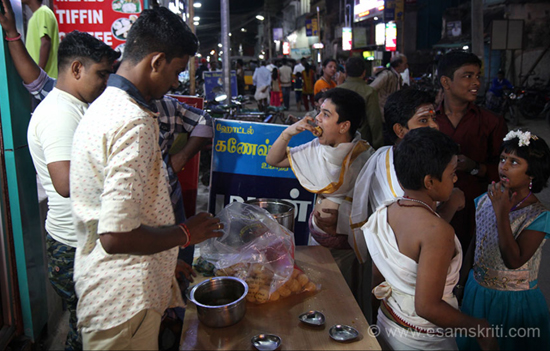 Tamil boys in Rameshwaram enjoying Gol Guppas. Store owned by a man from Rajasthan.
Tamil boys in Rameshwaram enjoying Gol Guppas. Store owned by a man from Rajasthan.
Also read
1.
What
is the ancient connect between Kashi and Tamil land
2.
Album
of Kashi Vishwanathar Temple, Tenkasi
3.
Album
of Rameshwaram Temple
4.
Album
of Dhanushkodi Island
5.
Album
Ramayana around Rameshwaram
6.
Why
Kashi is a pilgrimage destination
7.
Album
of Kanchi Kailasanathat Temple
8.
Album
of temple at Thiruvannamalai
9.
Album
of Chidambaram Nataraja Temple
10.
Album
of Thiyagaraja Temple, Tiruvarur
Author Dr Ketu Ramachandrasekhar is Program Manager at Bharatiya Samskriti Trust, a Non-Profitable Organisation dedicated towards the dissemination of Indic Knowledge Systems and resurgence of the Oldest Living Cultural way of life i.e. Sanatana Dharma. He has his Doctorate in Indian Epistemology and was selected as a Fellow from hundred young scholars across India for Studies in Neuro Aesthetics and Indian Rhetoric by Ministry of Culture, GOI. He was a part of Academic Team of scholars across Europe on discussion of Natya Texts. His expertise in Shaiva Pratyabhijna School is well recognised by scholars of Kashmir Shaivism and he has been a regular contributor to their Journals on the works and contributions of Acharya Abhinavagupta. He has several research articles and books to his credit which includes a detailed study of Abhinayadarpana of Nandikeshvara, Devi Mahatmya and others. His advice is also sought in matters relating to prayoga aspect of Tantra Shastra by established centers of Shakti worship like Kollur and Kanchipura.